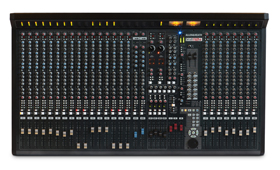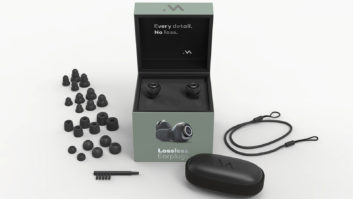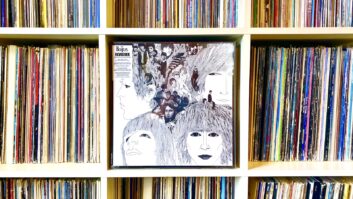
The GS-R24M from Allen & Heath exemplifies the concept of a “hybrid” console, merging analog and digital mixing capabilities with onboard A/D and D/A. The console boasts a comprehensive analog feature set, and adding the optional FireWire+ADAT interface card allows the GS-R24M to serve as your DAW interface, providing 32 FireWire I/Os at sample rates up to 96 kHz. The GS-R24M also incorporates DAW fader and transport control. That’s quite a bit in one package. While I don’t have the space to detail every feature, we’ll take a look at the major points.
Each of the GS-R24M’s 24 mono input channels has a rear panel TRS line in, direct output and insert (tip=send, ring=return), plus an XLR mic input. Preamp controls include gain, 48-volt phantom power, polarity reverse (which applies to both line and mic signals) and a 100Hz highpass filter. The 4-band EQ features fixed high (12kHz) and low-shelf (80Hz) bands, parametric high-midrange and low-midrange, and an EQ on/off switch. Six aux sends are configured as follows: aux 1 and 2 are pre-fader, auxes 3 and 4 may be switched pre or post-fader, and auxes 5 and 6 are post-fader but may be changed to pre-fader using internal jumpers. Bus assignment includes L/R, groups 1 through 4 and an independent mono bus. Directly beneath the bus assignment are four Interface Configuration switches, which I’ll discuss. At the bottom of the channel are mute and solo switches, and a 100mm touch-sensitive, motorized fader.

Two rear panel stereo inputs (TRS and RCA) are provided for each stereo channel strip. Stereo inputs 1 and 3 may be routed directly to the L/R bus or to the channel where they sum with stereo inputs 2/4 respectively, and have access to 4-band (fixed) EQ, auxes, bus routing and (non-motorized) fader. Stereo inputs 1 and 2 are controlled by the channel strip called Stereo 1. Stereo inputs 3 and 4 are controlled by the channel strip called Stereo 2. Confused? So was I.
YOO TOOB
Channels 29 and 30 are “Valve Channels” that source from XLR, ¼-inch or DAW return inputs. These channels have phantom power, polarity reverse, level, pan and bus assign. The high-impedance (10MΩ) ¼-inch input is line-level, but a switch boosts the input sensitivity for DI use, which sounded great on synths and clean guitar. A drive control allows you to smack the tube amplification stage hard for some tube mojo, but the effect is subtle. Cranking the drive on DAW tracks added some attitude to snare drum or a bit of growl to a bass DI, but was not kind to kick drums. Access to the tube for replacement is from the bottom panel.
A recessed switch labeled 17-24=Grp+Aux swaps channels 17-24 with the four group outs and the four aux outs—making it easy to group channels for recording onto the same DAW track. During a mix session I used this feature to send from the console to a reverb in the DAW.
THE FOUR BUTTONS
Four Interface Configuration switches (A, B, C and D) determine routing options for each channel. A clear understanding of their functions is crucial to exploiting the GS-R24M’s capabilities. When the FireWire+ADAT card is set to FireWire Only, every input has a “FireWire direct out” to the DAW, and a FireWire return from the DAW. The card supports other modes: ADAT Only, where the 32 FireWire I/Os are replaced with ADAT I/Os; and ADAT+FireWire, where buses 1-24 are FireWire and 25-32 are ADAT.
Think of the GS-R24M as an inline analog desk where the multitrack tape sends and returns have been replaced with FireWire DAW sends and returns. When all switches are up, the GS-R24M behaves like a “normal” analog mixer, routing mic/line signals through the channel and bus assignment, and providing latency-free monitoring. The bonus here is that the DAW sends are active, tapping the channel post-preamp/HPF and pre-everything else—enabling the desk to be used for live mixing (house and monitor mixes) while the FireWire sends are bused into your choice of DAW, undisturbed by EQ or inserts. Because the analog direct outs are also active, you could simultaneously record to a backup system in critical situations. Tré kewl.

When switch “A” is engaged, signal to the DAW is post-EQ and post-insert. Switch “B” replaces the mic/line input with the DAW return, pre-insert and pre-EQ. That means that rear panel analog inserts and channel EQ apply to the DAW returns—a really slick feature. Switch “C” also engages the DAW return, only this time it’s post-EQ and insert, so you can monitor the DAW output while using the EQ and insert on the signal going to the DAW. Switch “D” is fader bypass at unity gain. When you want to mix “in the box,” use the Digital Master Return to monitor (see below), and set D for bypass so that moving a console fader changes the DAW fader but leaves the channel’s audio level untouched. On the other hand, you can turn off D, set the DAW channels to unity, and use the GS-R24M as a summing mixer.
OUTPUT SECTION
Each of two studio outputs can independently source from any output bus. The master section is equally impressive with LED metering for the L/R bus (this, in addition to the meter bridge VUs), talkback, headphone out, control room monitor source, alternate speakers, control room level, and a mono button. Dubbing switches allow copying from 2-track 1 to 2-track 2 or vice versa, which is very convenient. “Digital Master” is a virtual 2-track return from the DAW on buses 31/32, which I used as the stereo return from Pro Tools and Digital Performer. Beware that the digital master return can be dumped back into the L/R mix, setting up the possibility of a feedback loop.
MIDI CONTROL
Before we discuss the GS-R24M as a DAW controller let’s make clear the separation of control and audio functions: The GS-R24M functioned flawlessly as the audio interface to my Mac Pro at all sample rates, regardless of clock source (I used internal, word and ADAT clock) and software (Pro Tools, Digital Performer and Record). Inputs and outputs automatically appeared when I launched software (albeit with some difficult-to-read names) and routing was a snap.
Using the GS-R24M as a DAW controller was disappointing. The desk requires purchase of a third-party utility called Bome’s MIDI Translator (approximately $85 U.S.), for which A&H provides mapping templates. At this price the desk should include all requisite software. The manual states that the console may be run in HUI emulation mode, but the template does not support fast-forward, rewind or fader banking—so there’s no fader control over channels past 24. To take full advantage of DAW control, be prepared to write your own Bome template. Fader read/write/on/off switches allow fader moves on the GS-R24M to be recorded by your DAW’s automation, and the console faders respond to DAW fader moves. At times, though, faders resisted manual movement (even with automation deactivated), or the DAW faders would not reflect movement of the hardware faders.
I also discovered an issue with the GS-R24M’s HUI mode. When the desk is set to HUI mode, the GS-R24M produces a MIDI tick. This tick cannot be isolated and infiltrates MIDI tracks when you attempt to record MIDI data from, for example, a keyboard controller. Setting the MIDI track’s input to the keyboard controller (as opposed to “all”) did not clear the issue, nor did turning off MIDI read/write on the faders. In fact, even if I removed the GS-R24M as a Pro Tools peripheral, the tick was still present in the MIDI stream.
AND FINALLY
Allen & Heath’s GS-R24M fantastically merges the requirements for routing and mixing DAW tracks with analog sources. It provides incredible flexibility for recording DAW tracks while monitoring the sources and/or creating front-of-house and monitor mixes. As expected from A&H, the audio path is clean and quiet, the mic pre’s are well designed and the desk features the company’s familiar EQ. As it stands, the GS-R24M is an excellent mixing console. If A&H make access to DAW control easier for Mac users, the GS-R24M will be a tour dé force.
[Ed. Note: As we went to press Allen & Heath was finalizing the implementation of the HUI protocol directly into the console, eliminating the need for the BOM Software translator. This will be a free firmware update to the console available in the very near future.]
Steve LaCerra is a New York–based live sound and recording engineer.








